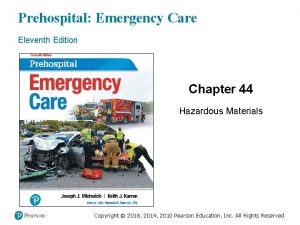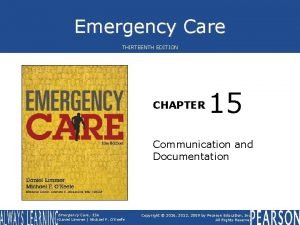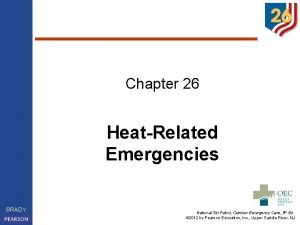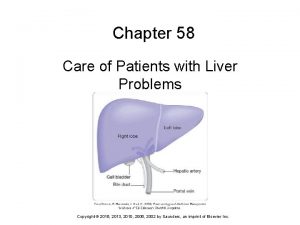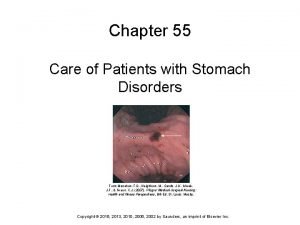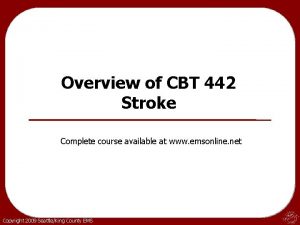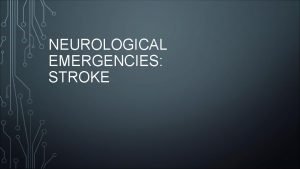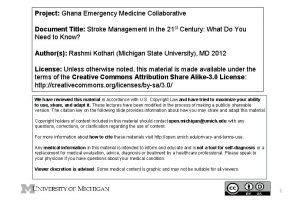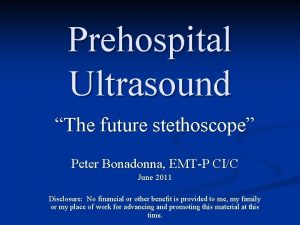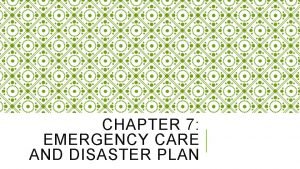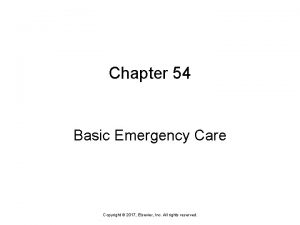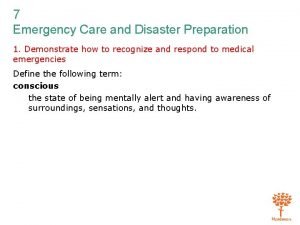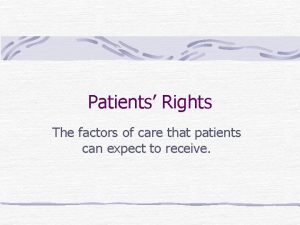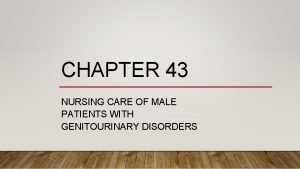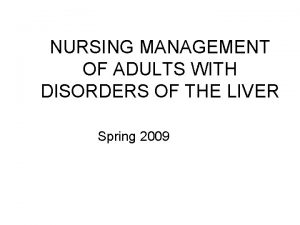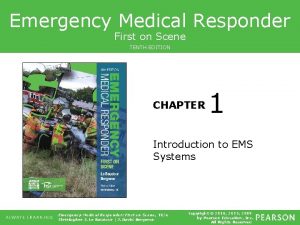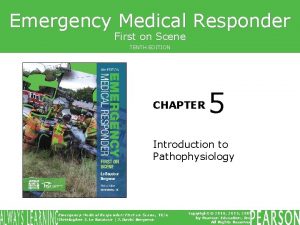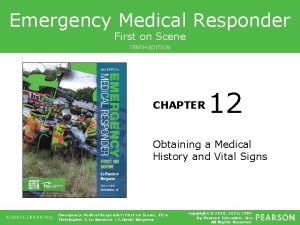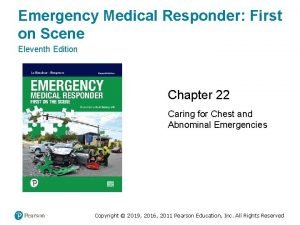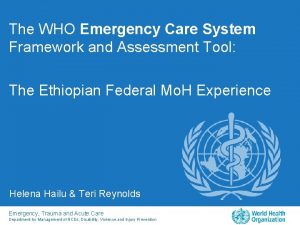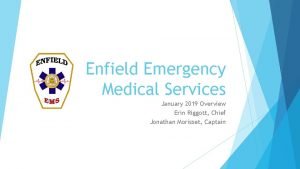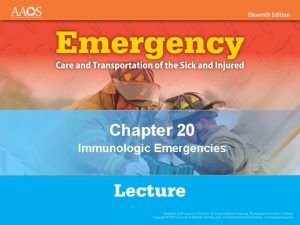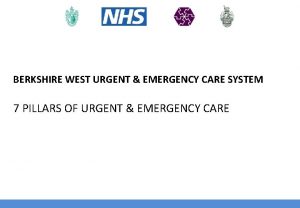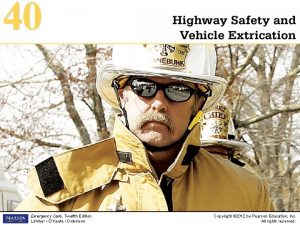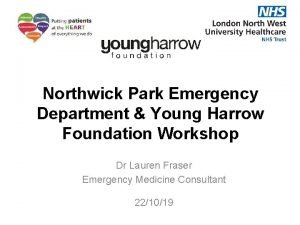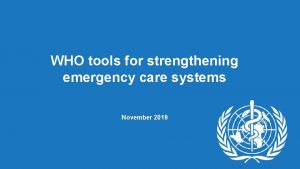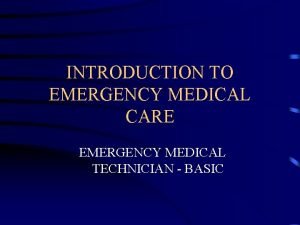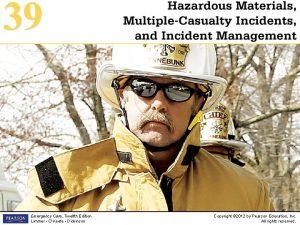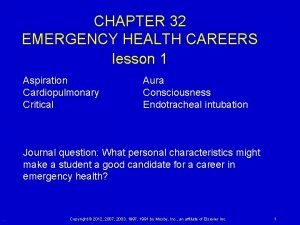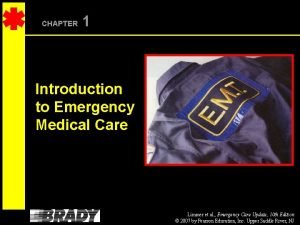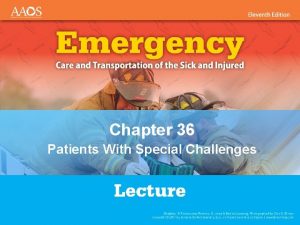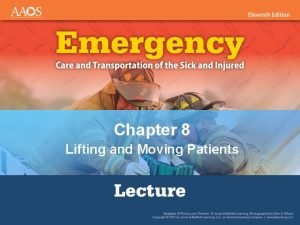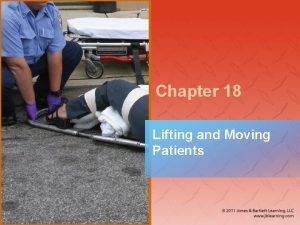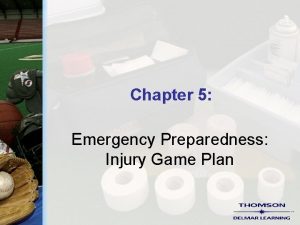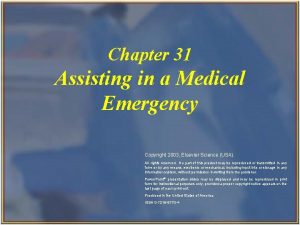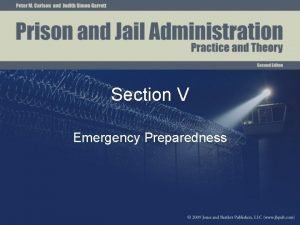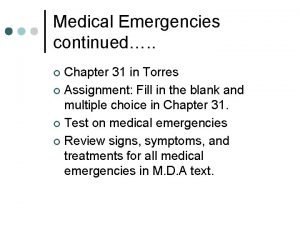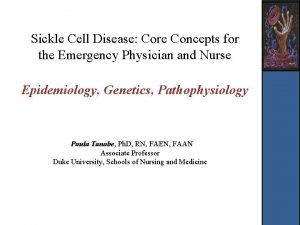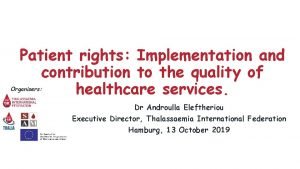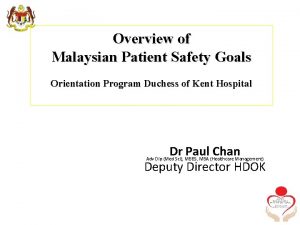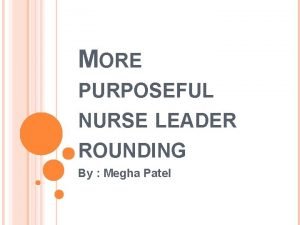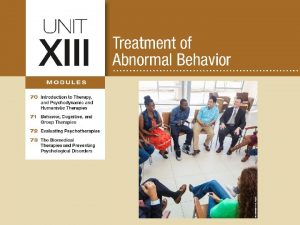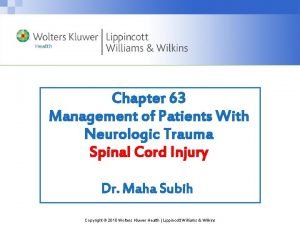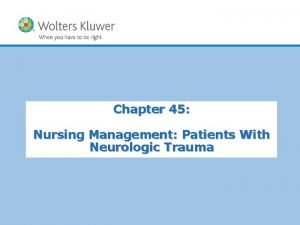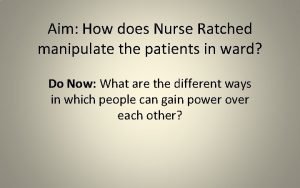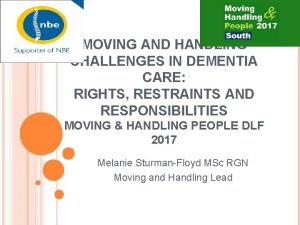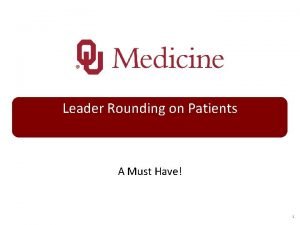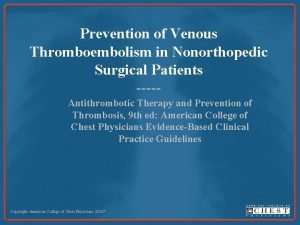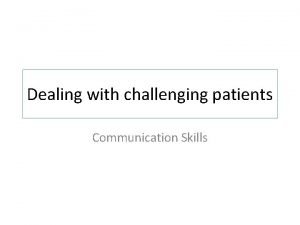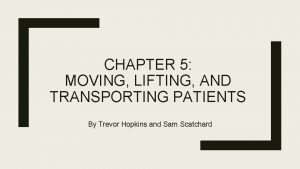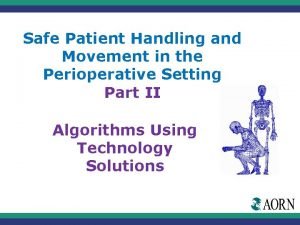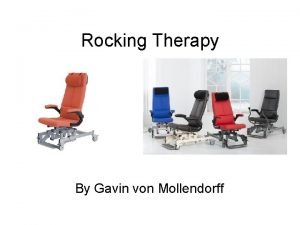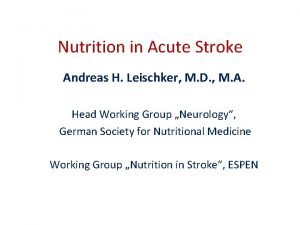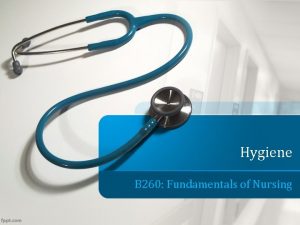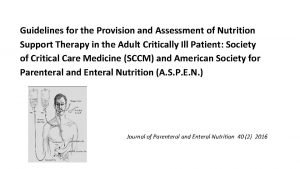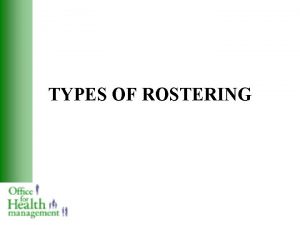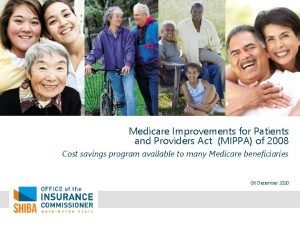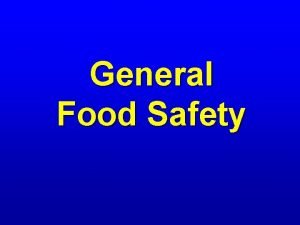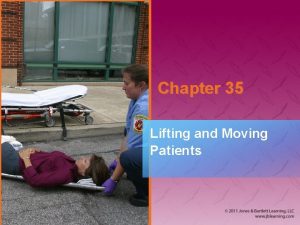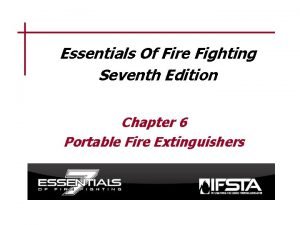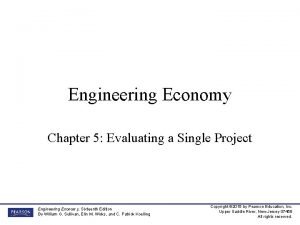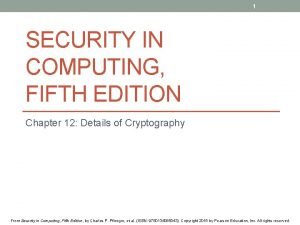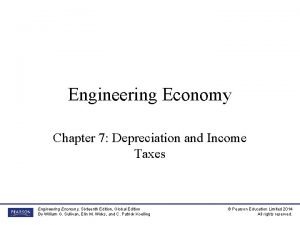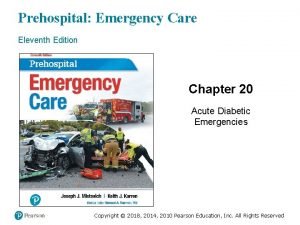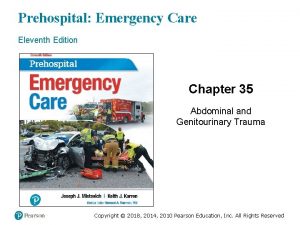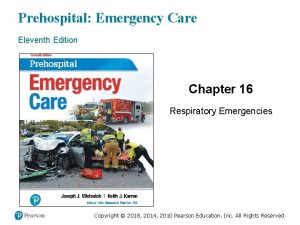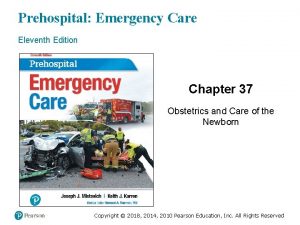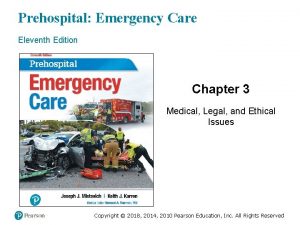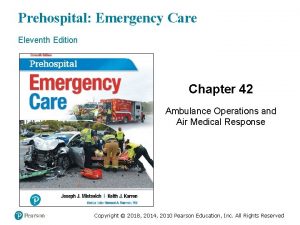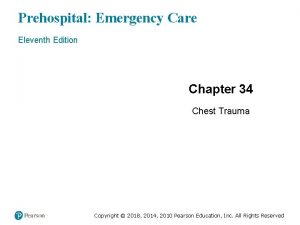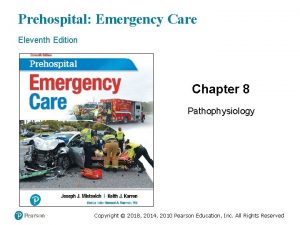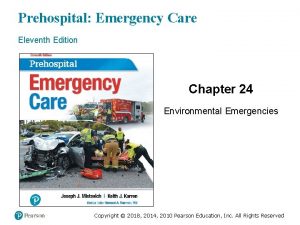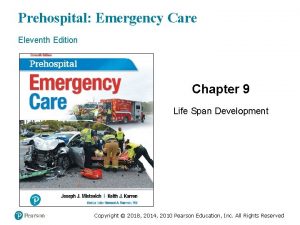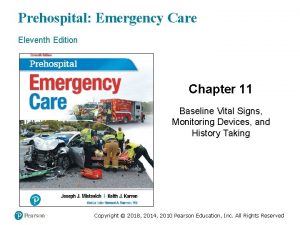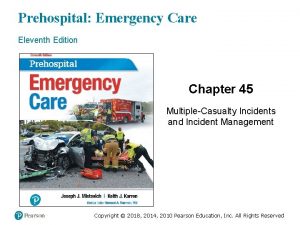Prehospital Emergency Care Eleventh Edition Chapter 40 Patients




































































































































- Slides: 132

Prehospital: Emergency Care Eleventh Edition Chapter 40 Patients with Special Challenges Slides in this presentation contain hyperlinks. JAWS users should be able to get a list of links by using INSERT+F 7 Copyright © 2018, 2014, 2010 Pearson Education, Inc. All Rights Reserved

Learning Readiness • EMS Education Standards, text p. 1209. • Chapter Objectives, text p. 1209. • Key Terms, text p. 1209 -1210. • Purpose of lecture presentation versus textbook reading assignments. Copyright © 2018, 2014, 2010 Pearson Education, Inc. All Rights Reserved

Setting the Stage (1 of 4) • Overview of Lesson Topics – Recognizing the Patient with Special Challenges – Sensory Impairments – Cognitive and Emotional Impairments – Paralysis – Obesity – Homelessness and Poverty Copyright © 2018, 2014, 2010 Pearson Education, Inc. All Rights Reserved

Setting the Stage (2 of 4) • Overview of Lesson Topics – Abuse – Human Trafficking – Domestic Violence – Technology Dependence – Airway and Respiratory Devices – Vascular Access Devices – Ventricular Assist Devices Copyright © 2018, 2014, 2010 Pearson Education, Inc. All Rights Reserved

Setting the Stage (3 of 4) • Overview of Lesson Topics – Vagus Nerve Stimulator – Terminally Ill Patients – Renal Failure and Dialysis – Gastrointestinal and Genitourinary Devices – Intraventricular Shunts – Terminally Ill Patients Copyright © 2018, 2014, 2010 Pearson Education, Inc. All Rights Reserved

Case Study Introduction (1 of 2) EMTs Alice Combs and Tristan Mullins arrive on a call for a patient whose home ventilator alarm is going off. They are met at the door by the patient’s mother, who says she has tried to determine the problem, but the alarm keeps going off. She tells the EMTs that her 23 -year-old son has been ventilator-dependent since becoming a quadriplegic in a car accident 8 years ago. Copyright © 2018, 2014, 2010 Pearson Education, Inc. All Rights Reserved

Case Study (1 of 7) • What are the first actions the EMTs should take? • What are some special concerns in the assessment of this patient? • What kinds of problems should be anticipated because of the patient’s ventilator and paralysis? Copyright © 2018, 2014, 2010 Pearson Education, Inc. All Rights Reserved

Introduction (1 of 2) • Some patients have special health challenges, ranging from obesity to homelessness to dependence on medical technology. • Medical technology ranges from hearing aids to mechanical ventilators. • Advances in medical technology allow people with certain medical problems to live at home. Copyright © 2018, 2014, 2010 Pearson Education, Inc. All Rights Reserved

Recognizing the Patient with Special Challenges • Any number of medical or traumatic conditions can cause a loss of function to a body system. • Impairments can result from aging, birth defects, chronic illnesses, traumas, abuse, neglect, and other causes. Copyright © 2018, 2014, 2010 Pearson Education, Inc. All Rights Reserved

Sensory Impairments (1 of 8) • Sensory impairment includes problems with hearing, vision, or speech. • Sensory deficits can lead to difficulty communicating. • There are steps that can improve communication with patients who have sensory deficits. Copyright © 2018, 2014, 2010 Pearson Education, Inc. All Rights Reserved

Sensory Impairments (2 of 8) • Hearing Impairment – Deafness is the inability to hear. – Deafness may involve one or both ears; a patient may be partially or totally deaf. Copyright © 2018, 2014, 2010 Pearson Education, Inc. All Rights Reserved

Sensory Impairments (3 of 8) • Vision Impairment – May be caused by disease, injury, or degenerative disorders. – Problems include glaucoma, diabetic retinopathy, and cataracts. – Vision loss can be acute or gradual. Copyright © 2018, 2014, 2010 Pearson Education, Inc. All Rights Reserved

Sensory Impairments (4 of 8) • Speech Impairment – Articulation disorders are caused by impairment of the tongue or other muscles. – The patient cannot pronounce words correctly. – Can result from learning words incorrectly or from a hearing impairment. Copyright © 2018, 2014, 2010 Pearson Education, Inc. All Rights Reserved

Sensory Impairments (5 of 8) • Speech Impairment – Voice production disorders occur from damage to the larynx or vocal cords. – The sounds produced may be harsh, hoarse, of unusual pitch, or have nasal distortion. Copyright © 2018, 2014, 2010 Pearson Education, Inc. All Rights Reserved

Sensory Impairments (6 of 8) • Accommodations for Patients with Sensory Impairments – Hearing Impairment ▪ Make sure hearing aids are available and turned on. ▪ Make sure the patient can see your face. ▪ Communicate in writing. ▪ Use a sign language interpreter, if available. Copyright © 2018, 2014, 2010 Pearson Education, Inc. All Rights Reserved

Sensory Impairments (7 of 8) • Accommodations for Patients with Sensory Impairments – Vision Impairment ▪ Speak clearly. ▪ Explain what you are going to do before you do it. ▪ Transport service animals, if possible. ▪ If necessary, allow the patient to place their hand on your arm or shoulder to guide them. Copyright © 2018, 2014, 2010 Pearson Education, Inc. All Rights Reserved

For the Visually Impaired Patient, Speak Clearly and Always Explain What You are Going to Do Copyright © 2018, 2014, 2010 Pearson Education, Inc. All Rights Reserved

Sensory Impairments (8 of 8) • Accommodations for Patients with Sensory Impairments – Speech Impairment ▪ Ask questions that allow the patient to answer in as few words as possible. ▪ Do not finish the patient’s words or statements for him. ▪ A speech impairment does not reflect cognitive ability. Copyright © 2018, 2014, 2010 Pearson Education, Inc. All Rights Reserved

Cognitive and Emotional Impairment (1 of 11) • Mental or Emotional Impairments – A patient with a psychosis struggles with interpreting reality and might not communicate effectively with you. – A patient with an extreme emotional dysfunction, such as depression or anxiety might not be able to focus on your questions or respond appropriately. Copyright © 2018, 2014, 2010 Pearson Education, Inc. All Rights Reserved

Cognitive and Emotional Impairment (2 of 11) • Developmental Disabilities – Interfere with how a body part or system operates – Can involve the brain, spinal cord, nervous system, and endocrine system. – Can cause speech impediments, behavioral disorders, language difficulties, and movement disorders. Copyright © 2018, 2014, 2010 Pearson Education, Inc. All Rights Reserved

Persons with Down Syndrome May Have Numerous Disabilities but Can Participate in Normal Activities with Help from Family and Friends (© Jotl/Science Source) Copyright © 2018, 2014, 2010 Pearson Education, Inc. All Rights Reserved

Cognitive and Emotional Impairment (3 of 11) • Autism and EMS – To better understand the autism patient keep in mind the following: ▪ Autism is identified by patient behavior. ▪ Patients might not communicate with you. ▪ Patients may develop a seizure disorder. ▪ They may have a difficult time reading facial expressions. ▪ Patients may have altered sensations. ▪ They are prone to positional asphyxia. Copyright © 2018, 2014, 2010 Pearson Education, Inc. All Rights Reserved

Cognitive and Emotional Impairment (4 of 11) • Autism and EMS – Autism Spectrum Disorder Foundation (ASDF) makes recommendations concerning the provision of emergency care. Copyright © 2018, 2014, 2010 Pearson Education, Inc. All Rights Reserved

Cognitive and Emotional Impairment (5 of 11) • Accommodations for patients with mental, emotional, or developmental impairments include: – Treat the patient with respect. – Rely on caregivers for information, if needed. – Compare the patient’s behavior to what is normal for him. – Provide clear explanations. Copyright © 2018, 2014, 2010 Pearson Education, Inc. All Rights Reserved

Cognitive and Emotional Impairment (6 of 11) • Accommodations for patients with mental, emotional, or developmental impairments include: – Patients are sensitive to tone of voice and body language. – Establish trust. – Avoid loud noises or extreme lighting changes. Copyright © 2018, 2014, 2010 Pearson Education, Inc. All Rights Reserved

Cognitive and Emotional Impairment (7 of 11) • Patients with Brain Injuries – Brain injury can result in permanent damage. – There may be changes in cognition, learning ability, emotions, and motor function. – Causes can include infant abuse, meningitis, encephalitis, and traumatic head injury. Copyright © 2018, 2014, 2010 Pearson Education, Inc. All Rights Reserved

Cognitive and Emotional Impairment (8 of 11) • Patients with Brain Injuries – Cerebral palsy ▪ Motor impairments arise early in development. ▪ The degree of impairment varies. ▪ There is difficulty controlling muscles, and there may be stiffness and contractures. Copyright © 2018, 2014, 2010 Pearson Education, Inc. All Rights Reserved

Cognitive and Emotional Impairment (9 of 11) • Patients with Brain Injuries – Cerebral Palsy ▪ Facial grimacing may occur. ▪ In some cases, there is cognitive impairment. ▪ There may be communication difficulties. Copyright © 2018, 2014, 2010 Pearson Education, Inc. All Rights Reserved

Cognitive and Emotional Impairment (10 of 11) • Patients with Brain Injuries – Disability from traumatic brain injury varies. – Disability ranges from mild speech impairment to being unresponsive and ventilator-dependent. Copyright © 2018, 2014, 2010 Pearson Education, Inc. All Rights Reserved

Cognitive and Emotional Impairment (11 of 11) • Accommodations for Patients with Brain Injuries – Distinguish between the baseline condition and acute changes. – Be aware of and manage any technology (pumps, ventilators, catheters) on which the patient relies. Copyright © 2018, 2014, 2010 Pearson Education, Inc. All Rights Reserved

Paralysis (1 of 3) • EMTs may respond to patients who have been paralyzed from past trauma or strokes. • Paralyzed patients are prone to a number of problems related to technology dependence, pressure sores, and infection. Copyright © 2018, 2014, 2010 Pearson Education, Inc. All Rights Reserved

Patients with Paralysis or Muscle Weakness May Want You to Arrange for Transport of their Assisting Devices, Such as Wheelchairs or Canes, to the Hospital (David M. Grossman/ Phototake. USA) Copyright © 2018, 2014, 2010 Pearson Education, Inc. All Rights Reserved

Paralysis (2 of 3) • Accommodations for Paralyzed Patients – A paraplegic displays paralysis from the waist down. – Follow protocols regarding transportation of wheelchairs. – For ventilator-dependent patients, keep the ventilator settings as you find them. – You may need to suction the breathing tube or stoma. Copyright © 2018, 2014, 2010 Pearson Education, Inc. All Rights Reserved

Paralysis (3 of 3) • Accommodations for Paralyzed Patients – Be alert to the possibility of a urinary catheter; keep the catheter bag below the level of insertion. – Make sure feeding tubes and colostomy bags are secured. – The family is usually knowledgeable about how to best move the patient. Copyright © 2018, 2014, 2010 Pearson Education, Inc. All Rights Reserved

Obesity (1 of 4) • Bariatrics is the branch of medicine that deals with the management of obese patients. • A person who is 20 percent or more over their ideal weight is obese. • A person who is more than 50 percent to 100 percent over their ideal weight, or more than 100 pounds over their ideal weight is morbidly obese. Copyright © 2018, 2014, 2010 Pearson Education, Inc. All Rights Reserved

Table 40 -1 Effects of Excess Weight on Body Systems System Disease State Cardiovascular Hypertension, coronary artery disease, congestive heart failure, stroke Respiratory Obstructive sleep apnea, asthma, chronic obstructive pulmonary disease Endocrine and reproductive Diabetes mellitus, infertility, birth defects, menstrual disorders Gastrointestinal Esophageal reflux, liver disease Musculoskeletal Osteoarthritis, gout, back injuries, immobility Psychological Depression, suicide Copyright © 2018, 2014, 2010 Pearson Education, Inc. All Rights Reserved

Assessment and Care of the Obese Patient Follows a Normal Format, but Modifications May be Required Because of the Patient‘s Size (© Mark C. Ide) Copyright © 2018, 2014, 2010 Pearson Education, Inc. All Rights Reserved

Obesity (2 of 4) • Accommodations for Obese Patients – Obese patients can have difficulty breathing in a supine position. – If the patient is unable to protect their own airway, position the head in a neutral position; you may need to place folded towels or bath blankets beneath the shoulders and neck. Copyright © 2018, 2014, 2010 Pearson Education, Inc. All Rights Reserved

Obesity (3 of 4) • Accommodations for Obese Patients – When the airway is ensured, turn your attention to oxygenating and ventilating the patient. – Pay particular attention to adequacy of respiratory rate and tidal volume. – Positive-pressure ventilation of obese patients is more difficult. Copyright © 2018, 2014, 2010 Pearson Education, Inc. All Rights Reserved

Obesity (4 of 4) • Accommodations for Obese Patients – Lifting and moving obese patients requires the assistance of an adequate number of providers. – Obese patients may exceed the structural limitations of standard ambulance cots, and may require the use of a bariatric device. Copyright © 2018, 2014, 2010 Pearson Education, Inc. All Rights Reserved

Bariatric Devices Include Special Cots Designed to Support the Greater Weight of an Obese Patient and Loading Devices Such as Ramps and Winches that Interface with Specially Designed Ambulance Cot. Locking Systems (© Ray Kemp/911 Imaging) Copyright © 2018, 2014, 2010 Pearson Education, Inc. All Rights Reserved

Homelessness and Poverty (1 of 6) • Factors that contribute to homelessness include – Poverty – Substance abuse – Lack of affordable housing – Mental illness – Returning to society after being in prison – Domestic violence – Mortgage foreclosure/forced eviction – Natural disasters Copyright © 2018, 2014, 2010 Pearson Education, Inc. All Rights Reserved

Homelessness and Poverty (2 of 6) • Issues Associated with Homelessness – Increased risk of violence and abuse – Increased risk of illness/disease – Discrimination from others – Reduced access to health care Copyright © 2018, 2014, 2010 Pearson Education, Inc. All Rights Reserved

Homelessness and Poverty (3 of 6) • Issues Associated with Homelessness – Risk of violence and abuse – Risk of illness/disease – Reduced access to health care – Limited or no access to education – Limited access to modern communications – Not seen as suitable for employment Copyright © 2018, 2014, 2010 Pearson Education, Inc. All Rights Reserved

EMS is Often Summoned to Street Corners and Other Public Places to Care for a Homeless Patient (© Mark C. Ide) Copyright © 2018, 2014, 2010 Pearson Education, Inc. All Rights Reserved

Homelessness and Poverty (4 of 6) • Places where the homeless may find refuge include: – Abandoned buildings – Public places—parks, train or bus stations, airports, and college campuses – Vehicles – Improvised shacks or sleeping bags – Unoccupied houses – Homeless shelters. Copyright © 2018, 2014, 2010 Pearson Education, Inc. All Rights Reserved

Homelessness and Poverty (5 of 6) • Patients in poverty may face many of the same issues as the homeless, including: – Accidental trauma – Physical abuse – Crime – Chronic medical conditions – Limited access to health care and medications. Copyright © 2018, 2014, 2010 Pearson Education, Inc. All Rights Reserved

People Who Fall Below the Poverty Level are at Great Risk for Illness and Injury Because of the Environment in Which they Live and a Lack of Resources with Which to Seek Primary Medical Care (© Mark C. Ide) Copyright © 2018, 2014, 2010 Pearson Education, Inc. All Rights Reserved

Homelessness and Poverty (6 of 6) • Accommodations for Patients Who Are Homeless or Poor – Do not be judgmental; display respect. – Be an advocate; realize the patient may need your help. – Become familiar with resources in your community. Copyright © 2018, 2014, 2010 Pearson Education, Inc. All Rights Reserved

Abuse • Abuse is any action or failure to act that results in unreasonable suffering, harm, or misery to a person, whether physical or mental. • Abuse transcends all age, gender, race, and socioeconomic groups. • Children, elders, and domestic/intimate partners are some of those who may be abused. Copyright © 2018, 2014, 2010 Pearson Education, Inc. All Rights Reserved

Click on the Problem that is Least Likely to be Associated with Homelessness A. Increased risk of violence B. Increased risk of environmental emergencies C. Increased risk of obesity D. Increased risk of accidental trauma Copyright © 2018, 2014, 2010 Pearson Education, Inc. All Rights Reserved

Human Trafficking (1 of 7) • You might be the only hope for the victim and have only one opportunity to save this individual from human traffickers. • The Victim of Human Trafficking – Common Characteristics of Victim of Human Trafficking ▪ Can be men or women, adults or children. Copyright © 2018, 2014, 2010 Pearson Education, Inc. All Rights Reserved

Human Trafficking (2 of 7) • The Victim of Human Trafficking – Common Characteristics of Victim of Human Trafficking ▪ Runaway and homeless youths ▪ Victims of domestic violence ▪ Victims of sexual assault ▪ Victims of social discrimination ▪ Victims of war or conflict Copyright © 2018, 2014, 2010 Pearson Education, Inc. All Rights Reserved

Human Trafficking (3 of 7) • The Victim of Human Trafficking – Common Characteristics of Victim of Human Trafficking ▪ Common Settings – Prostitution rings and escort services – Pornography industry, stripping or exotic dancing clubs – Massage parlors – Agricultural farms or ranches – Factories or sweatshops – Hotels, nail salons, home-cleanings Copyright © 2018, 2014, 2010 Pearson Education, Inc. All Rights Reserved

Human Trafficking (4 of 7) • The Victim of Human Trafficking – Common Characteristics of Victims of Human Trafficking ▪ Victim characteristics – Controlled physically or psychologically by someone at the scene – Doesn’t have the ability to leave – All information is provided by someone else – No identification – Few or no personal possessions Copyright © 2018, 2014, 2010 Pearson Education, Inc. All Rights Reserved

Human Trafficking (5 of 7) • The Victim of Human Trafficking – Psychological and behavioral clues to help identify a victim of human trafficking ▪ Exhibits a feeling of helplessness, shame, guilt, self-blame, or humiliation ▪ Has an eating or sleep disorders ▪ Is addicted to drugs or alcohol ▪ Appears to be emotionally numb ▪ Shows evidence of “trauma bonding” with the trafficker. Copyright © 2018, 2014, 2010 Pearson Education, Inc. All Rights Reserved

Human Trafficking (6 of 7) • The Victim of Human Trafficking – Physical clues to help identify a victim of human trafficking include: ▪ Signs of physical abuse ▪ Chronic back, visual, or hearing problems ▪ Skin or respiratory conditions ▪ Diseases such as tuberculosis and hepatitis ▪ Clearly visible tattoos ▪ Inappropriate clothing for the weather. Copyright © 2018, 2014, 2010 Pearson Education, Inc. All Rights Reserved

Human Trafficking (7 of 7) • EMS Management for a Suspected Victim of Human Trafficking – Ensure the scene is safe. – Provide emergency care for any illness or injury, according to your protocol. – If you cannot transport the victim, contact local law enforcement. Copyright © 2018, 2014, 2010 Pearson Education, Inc. All Rights Reserved

Domestic Violence (1 of 7) • The Victim of Domestic Violence – Women who are at the highest risk of being subjected to domestic violence are: ▪ Separated or divorced ▪ Minorities ▪ Disabled ▪ Pregnant ▪ Cohabitating with a same-sex partner – The abuser typically isolates the victim. Copyright © 2018, 2014, 2010 Pearson Education, Inc. All Rights Reserved

Domestic Violence (2 of 7) • The Victim of Domestic Violence – Types of Domestic Abuse ▪ The use of physical force ▪ The use of derogatory terms ▪ Threat and degrading behavior ▪ Sexual activity with the victim without consent ▪ Victim not permitted to practice religion ▪ Financial or material control Copyright © 2018, 2014, 2010 Pearson Education, Inc. All Rights Reserved

Domestic Violence (3 of 7) • The Domestic Violence Victim – Cycle of Violence ▪ Phase One—The tension between the victim and abuser increases. ▪ Phase Two—Violence occurs regularly. – Increases in frequency and severity. ▪ Phase Three—Referred to as “honeymoon” phase, in which the abuser apologizes, sometimes buying the victim gifts. Copyright © 2018, 2014, 2010 Pearson Education, Inc. All Rights Reserved

Domestic Violence (4 of 7) • EMS Management for a Victim of Domestic Abuse or Violence – Assessment Findings of Domestic Abuse ▪ Physical ▪ Emotional and psychological ▪ Psychiatric ▪ Sexual Copyright © 2018, 2014, 2010 Pearson Education, Inc. All Rights Reserved

Domestic Violence (5 of 7) • EMS Management for a Victim of Domestic Abuse or Violence – Approaching the Scene and Victim of Domestic Violence ▪ Ensure the scene is safe before entering. ▪ Do not confront the abuser or the victim. ▪ Do not get between the abuser and victim. ▪ Do not allow the abuser or victim to get between you and the door. Copyright © 2018, 2014, 2010 Pearson Education, Inc. All Rights Reserved

Domestic Violence (6 of 7) • EMS Management for a Victim of Domestic Abuse or Violence – Approaching the Scene and Victim of Domestic Violence ▪ When away from the abuser, ask the victim about the abuse. An example of this kind of question could be, “Violence against women has become a health issue. I ask all my female patients if they have ever experienced any abuse. Have you been abused as a child or adult? ” Copyright © 2018, 2014, 2010 Pearson Education, Inc. All Rights Reserved

Domestic Violence (7 of 7) • EMS Management for a Victim of Domestic Abuse or Violence – Preserving Evidence and Documentation ▪ Do not destroy any possible evidence. ▪ On your PCR, perform the following: – Include location and description of injuries. – Report the mechanism of injury. – Note any injury patterns. – Objectively note any comments made by the victim. Copyright © 2018, 2014, 2010 Pearson Education, Inc. All Rights Reserved

Technology Dependence (1 of 5) • Many patients who once required hospital care can now be cared for at home, in part due to medical technology. • Technology may be life-enhancing or life-sustaining. Copyright © 2018, 2014, 2010 Pearson Education, Inc. All Rights Reserved

Technology Dependence (2 of 5) • Reasons EMS may be summoned include: – Failed equipment – A change in the patient’s clinical condition – Patient experiencing some other emergency. Copyright © 2018, 2014, 2010 Pearson Education, Inc. All Rights Reserved

Technology Dependence (3 of 5) • EMTs must have a basic understanding of the technology a patient is using. • You will often have to rely on the patient or their caregivers for specific information about the equipment. Copyright © 2018, 2014, 2010 Pearson Education, Inc. All Rights Reserved

The Patient’s Primary Health Care Provider Can Usually Provide Information about the Equipment on Which the Patient Relies Copyright © 2018, 2014, 2010 Pearson Education, Inc. All Rights Reserved

Technology Dependence (4 of 5) • Questions to ask about technology include: – Where can I get device information? – What does this device do? – Can I replicate its function if it fails? – Will the device have an effect on the assessment or findings? – Has this problem ever occurred before? – How was it fixed? – Has someone tried to remedy the issue? Copyright © 2018, 2014, 2010 Pearson Education, Inc. All Rights Reserved

Technology Dependence (5 of 5) • Focus on these tasks: – Keep the airway open. – Establish and maintain adequate ventilation. – Maintain adequate oxygenation. – Support circulation as needed. Copyright © 2018, 2014, 2010 Pearson Education, Inc. All Rights Reserved

Case Study (2 of 7) Alice and Tristan find an alert 23 -year-old who is ventilator -dependent, but can speak by plugging their tracheostomy tube. The patient’s skin is hot, and as the EMTs begin their assessment, the high-pressure alarm goes off on the ventilator. Copyright © 2018, 2014, 2010 Pearson Education, Inc. All Rights Reserved

Case Study (3 of 7) • What does the high-pressure alarm signify? • What are possible causes of the high-pressure alarm? • How can the EMTs assess the patient and their device for those causes? • What should the EMTs do with the ventilator as they prepare the patient for transport? Copyright © 2018, 2014, 2010 Pearson Education, Inc. All Rights Reserved

Airway and Respiratory Devices (1 of 18) • Medical Oxygen – Home oxygen equipment is similar to what you are used to. – Oxygen may be supplied from a cylinder, oxygen concentrator, or liquid oxygen system. Copyright © 2018, 2014, 2010 Pearson Education, Inc. All Rights Reserved

Table 40 -2 Common Technical Problems with Oxygen Systems Problem Possible Cause Corrective Action Oxygen not flowing freely Faulty tubing Check for obstruction or replace tubing. Oxygen not flowing freely Dirty or plugged humidifier Remove from oxygen supply, clean, and refill with sterile water or replace with prefilled bottle. Buzzer goes off on oxygen concentrator Unit unplugged Check plug. Buzzer goes off on oxygen concentrator Power failure Check fuses, circuit breaker, or, in cases of power outages, use backup oxygen tank until power is restored. (Or call EMS as necessary to make use of oxygen administration from the ambulance or at the hospital. ) Oxygen tank empties too quickly or hisses Leak in tank Open all windows, extinguish all flames, and summon help from the fire department, E MS, and/or supplier. Copyright © 2018, 2014, 2010 Pearson Education, Inc. All Rights Reserved

Airway and Respiratory Devices (2 of 18) • Apnea Monitors – Designed to constantly monitor the patient’s breathing and emit a warning signal should breathing cease – May also monitor heart rate – Used for some babies, especially premature newborns Copyright © 2018, 2014, 2010 Pearson Education, Inc. All Rights Reserved

Airway and Respiratory Devices (3 of 18) • Apnea Monitors – Determine how long the monitor has been emitting an alert. – Determine whether the caregivers have performed any interventions. – If the patient is breathing normally, provide oxygen to the infant and transport them to the hospital for evaluation. Copyright © 2018, 2014, 2010 Pearson Education, Inc. All Rights Reserved

Airway and Respiratory Devices (4 of 18) • Pulse Oximetry – It may be used at home by patients with apnea monitors or respiratory problems – Treat the patient for the presenting problem. – Apply the pulse oximeter from the ambulance. – Ascertain what interventions, if any, were done. Copyright © 2018, 2014, 2010 Pearson Education, Inc. All Rights Reserved

Airway and Respiratory Devices (5 of 18) • Tracheostomy Tubes – A tracheostomy is a surgical opening into the trachea to provide an alternative route for airflow, bypassing the nose and mouth. – A tracheostomy may be temporary or permanent. – A permanent opening is a stoma. Copyright © 2018, 2014, 2010 Pearson Education, Inc. All Rights Reserved

Airway and Respiratory Devices (6 of 18) • Tracheostomy Tubes – A tracheostomy tube is placed into the tracheostomy to keep it patent. – The tube may be single or double-lumen. – A patient with a tracheostomy may or may not be able to speak. – Emergencies include tube obstruction by mucus or a dislodged inner cannula. Copyright © 2018, 2014, 2010 Pearson Education, Inc. All Rights Reserved

A Tracheostomy Tube for Older Children and Adults Has an Outer Cannula and an Inner Cannula Copyright © 2018, 2014, 2010 Pearson Education, Inc. All Rights Reserved

Airway and Respiratory Devices (7 of 18) • Tracheostomy Tubes – To suction: ▪ Measure the depth of insertion for the suction catheter by comparing it to the tracheostomy tube obturator. ▪ Apply suction; slowly withdraw the catheter while twisting it between your fingers. ▪ Rinse the suction catheter with sterile water between attempts. Copyright © 2018, 2014, 2010 Pearson Education, Inc. All Rights Reserved

Use a Soft-Suction Catheter to Clear Blood or Secretions from the Tracheostomy Tube Copyright © 2018, 2014, 2010 Pearson Education, Inc. All Rights Reserved

Airway and Respiratory Devices (8 of 18) • CPAP and Bi. PAP – Continuous positive-airway pressure/bilevel positiveairway pressure – Both provide therapeutic back pressure during respiration. – Some CPAP and Bi. PAP machines also allow the administration of oxygen during their use. Copyright © 2018, 2014, 2010 Pearson Education, Inc. All Rights Reserved

Airway and Respiratory Devices (9 of 18) • CPAP and Bi. PAP – Keep the bronchioles open during exhalation, which improves oxygenation and ventilation and decreases the work of breathing. – It is commonly used by patients with COPD or sleep apnea. Copyright © 2018, 2014, 2010 Pearson Education, Inc. All Rights Reserved

Airway and Respiratory Devices (10 of 18) • Home Mechanical Ventilators – Patients may depend on a ventilator because of nervous system disorders, neuromuscular disease, or other problems. – Home units vary in size. – They can vary significantly in cost and sophistication. Copyright © 2018, 2014, 2010 Pearson Education, Inc. All Rights Reserved

Airway and Respiratory Devices (11 of 18) • Mechanical Ventilators – Settings include rate, tidal volume, and in some cases, the amount of oxygen provided. – The tubing, called a ventilator circuit, attaches to the patient’s tracheostomy tube. Copyright © 2018, 2014, 2010 Pearson Education, Inc. All Rights Reserved

Airway and Respiratory Devices (12 of 18) • Mechanical Ventilators – A high-pressure alarm is activated when the pressure needed for lung inflation exceeds the present value. ▪ Causes include: – Secretions occluding the tracheostomy tube – Kinked ventilator circuit – Tracheotomy tube movement. Copyright © 2018, 2014, 2010 Pearson Education, Inc. All Rights Reserved

Airway and Respiratory Devices (13 of 18) • Mechanical Ventilators – A low-pressure alarm is activated when the tidal volume falls 50— 100 m L below the set tidal volume. ▪ This indicates a problem in the breathing circuit, such as a disconnected segment or a leak in the tracheostomy tube cuff. illi iter Copyright © 2018, 2014, 2010 Pearson Education, Inc. All Rights Reserved

Airway and Respiratory Devices (14 of 18) • Mechanical Ventilators – Apnea Alarm ▪ Some patients on a ventilator may have some respiratory effort, and the ventilator is set to trigger when the patient takes a breath. ▪ The apnea alarm triggers when the patient stops breathing. – A low Fi. O 2 alarm occurs when the oxygen is disconnected or depleted. Copyright © 2018, 2014, 2010 Pearson Education, Inc. All Rights Reserved

Airway and Respiratory Devices (15 of 18) • Mechanical Ventilators – Ventilator alarms can represent a change in the patient’s clinical condition or a problem with the ventilator. – Troubleshoot the patient and the ventilator. Copyright © 2018, 2014, 2010 Pearson Education, Inc. All Rights Reserved

Airway and Respiratory Devices (16 of 18) • Accommodations for Patients with Airway or Respiratory Devices – Because the device is used to support or replace a lost function, you must assess its adequacy in doing so. – You also will perform your usual primary assessment, history, and physical exam in the usual order. Copyright © 2018, 2014, 2010 Pearson Education, Inc. All Rights Reserved

Airway and Respiratory Devices (17 of 18) • Accommodations for Patients with Airway or Respiratory Devices – You may need to suction a tracheostomy tube. – For patients with ventilators, troubleshoot both the device and the patient. Copyright © 2018, 2014, 2010 Pearson Education, Inc. All Rights Reserved

Airway and Respiratory Devices (18 of 18) • Accommodations for Patients with Airway or Respiratory Devices – If the ventilator provides adequate ventilation, allow it to do its job. – If the ventilator does not provide adequate ventilations, you will need to use a bag-valve-mask device. – Ensure you have adequate help to move the patient and the ventilator. Copyright © 2018, 2014, 2010 Pearson Education, Inc. All Rights Reserved

You Can Ventilate a Patient with a Tracheostomy by Attaching the Bag-Valve Device to the Tracheostomy Tube’s 15 over 22 m m Adapter illi eter Copyright © 2018, 2014, 2010 Pearson Education, Inc. All Rights Reserved

Vascular Access Devices (1 of 3) • Patients may have a vascular access device (VAD) for chemotherapy, dialysis, total parenteral nutrition, or antibiotic therapy. • VADs may be placed in a variety of locations. • The device may have an external catheter portion, or may be a port implanted under the skin. Copyright © 2018, 2014, 2010 Pearson Education, Inc. All Rights Reserved

Vascular Access Devices (2 of 3) • Central Intravenous Catheters – Long, thin, hollow catheter inserted into a vein of the arm, neck, or subclavian vein, just below the clavicle • Central Venous Lines – Port secured to the anterior chest, just below the clavicle. • Implanted Ports – Surgically placed beneath the skin Copyright © 2018, 2014, 2010 Pearson Education, Inc. All Rights Reserved

Vascular Access Devices Include Central IV Catheters Such as a PICC Line, Central Venous Lines Such as the Broviac Catheter, and Implanted Ports Such as the Mediport System Copyright © 2018, 2014, 2010 Pearson Education, Inc. All Rights Reserved

Vascular Access Devices (3 of 3) • Accommodations for Patients with Vascular Access Devices – Obstruction by a blood clot may occur. – Patients may take anticoagulants. – Air embolism may occur. – Note any bleeding or signs of infection. – The EMT does not access vascular access devices for medication administration. Copyright © 2018, 2014, 2010 Pearson Education, Inc. All Rights Reserved

Vagus Nerve Stimulator • Implanted device found in patients with a seizure disorder • Accommodations for Patients with a VNS – If a patient is actively seizing or feels as if they are about to have a seizure because of an aura, a special magnet can be passed over the device to trigger it to deliver a burst of electrical energy. Copyright © 2018, 2014, 2010 Pearson Education, Inc. All Rights Reserved

Renal Failure and Dialysis (1 of 5) • Acute renal failure (ARF) occurs when there is a rapid loss of renal function. • ARF is often reversible. • Chronic renal failure (CRF) occurs when there is a progressive loss of kidney function over a period of months to years. • Dialysis removes the buildup of toxins the kidneys can no longer filter. Copyright © 2018, 2014, 2010 Pearson Education, Inc. All Rights Reserved

Renal Failure and Dialysis (2 of 5) • Hemodialysis – Blood is extracted from the body and sent through a machine called a dialyzer. – The procedure is performed in a dialysis center. – It requires a dialysis shunt to remove blood from the body and return it. Copyright © 2018, 2014, 2010 Pearson Education, Inc. All Rights Reserved

Renal Failure and Dialysis (3 of 5) • Peritoneal Dialysis – Fluid is placed in the peritoneal cavity through a port, where it acts to remove wastes, and is then emptied from the peritoneal cavity. – Dialysis can be performed at home, but it is less effective. Copyright © 2018, 2014, 2010 Pearson Education, Inc. All Rights Reserved

Renal Failure and Dialysis (4 of 5) • Accommodations for Patients on Dialysis – If a patient is receiving dialysis at a facility and is still attached to the dialysis machine, do not attempt to remove the patient prematurely. – Only dialysis center staff should remove the patient from the machine. Copyright © 2018, 2014, 2010 Pearson Education, Inc. All Rights Reserved

Renal Failure and Dialysis (5 of 5) • Accommodations for Patients on Dialysis – Patients with peritoneal dialysis may develop peritonitis or inflammation at the insertion site, or the catheter may be dislodged. Copyright © 2018, 2014, 2010 Pearson Education, Inc. All Rights Reserved

Gastrointestinal and Genitourinary Devices (1 of 5) • Feeding Tubes – Feeding tubes are used to provide nutrition to patients who cannot chew or swallow. – Feeding tubes include nasogastric tubes, orogastric tubes, and jejunal tubes. Copyright © 2018, 2014, 2010 Pearson Education, Inc. All Rights Reserved

For Long-Term Nutritional Support, a Feeding Tube May be Surgically Inserted through the Abdominal Wall and Directly into the Gastrointestinal System Copyright © 2018, 2014, 2010 Pearson Education, Inc. All Rights Reserved

Gastrointestinal and Genitourinary Devices (2 of 5) • Ostomy Bags – A surgical opening through the abdominal wall to which a section of bowel is diverted so that fecal material is directed outside the body into the bag Copyright © 2018, 2014, 2010 Pearson Education, Inc. All Rights Reserved

Ostomy Stomas May be Found at Various Abdominal Locations Copyright © 2018, 2014, 2010 Pearson Education, Inc. All Rights Reserved

Gastrointestinal and Genitourinary Devices (3 of 5) • Urinary Tract Devices – A urinary catheter is used to empty the bladder when there is a urinary tract dysfunction. – Urinary Tract Device Types: ▪ Texas—External catheter ▪ Foley—Indwelling through the urethra ▪ Suprapubic—Surgically inserted through the abdominal wall Copyright © 2018, 2014, 2010 Pearson Education, Inc. All Rights Reserved

An External Urinary Catheter Copyright © 2018, 2014, 2010 Pearson Education, Inc. All Rights Reserved

An Internal Urinary Catheter with Balloon Copyright © 2018, 2014, 2010 Pearson Education, Inc. All Rights Reserved

Gastrointestinal and Genitourinary Devices (4 of 5) • Accommodations for Patients with Gastrointestinal and Genitourinary Devices – Problems include obstruction, infection, and displacement. ▪ If a device is dislodged, do not attempt to replace it. Copyright © 2018, 2014, 2010 Pearson Education, Inc. All Rights Reserved

Gastrointestinal and Genitourinary Devices (5 of 5) • Accommodations for Patients with Gastrointestinal and Genitourinary Devices – Drain catheter bags prior to transport and document the appearance and amount of urine. – Keep the catheter bag lower than the site of insertion. Copyright © 2018, 2014, 2010 Pearson Education, Inc. All Rights Reserved

Intraventricular Shunts (1 of 4) • Hydrocephalus occurs when excess cerebrospinal fluid accumulates, which can cause increased intracranial pressure. • An intraventricular shunt allows the excess fluid to drain. Copyright © 2018, 2014, 2010 Pearson Education, Inc. All Rights Reserved

Intraventricular Shunts Allow Excess Cerebrospinal Fluid to Drain from the Brain to a Site in the Neck, Heart, Pleural Space, or Abdomen, or into a Reservoir Beneath the Scalp Copyright © 2018, 2014, 2010 Pearson Education, Inc. All Rights Reserved

Intraventricular Shunts (2 of 4) • Complications include infection, shunt occlusion, and subdural bleeding. • Infection may present with malaise, fever, and headache. Copyright © 2018, 2014, 2010 Pearson Education, Inc. All Rights Reserved

Intraventricular Shunts (3 of 4) • Shunt obstruction causes the following signs of increased intracranial pressure: – Headache/Seizures – Vomiting – Altered mental status – Sensory or motor dysfunction – Respiratory depression – Pupil changes – Increased blood pressure. Copyright © 2018, 2014, 2010 Pearson Education, Inc. All Rights Reserved

Intraventricular Shunts (4 of 4) • Accommodations for Patients with Intraventricular Shunts – Initial complaints include confusion, difficulty with simple tasks, and headaches. ▪ Manage the airway and if breathing is inadequate, provide positive-pressure ventilation with oxygen. Copyright © 2018, 2014, 2010 Pearson Education, Inc. All Rights Reserved

Terminally Ill Patients (1 of 3) • The life expectancy of a terminally ill patient is generally 6 months or less. • Patients may receive palliative care. • Hospice is a philosophy of care aimed at palliation of symptoms for patients and support for their families. Copyright © 2018, 2014, 2010 Pearson Education, Inc. All Rights Reserved

Terminally Ill Patients (2 of 3) • Patients receiving hospice care often are ill with the following: – Cancer – AIDS – Alzheimer’s disease – Cystic fibrosis – Congestive heart failure – COPD. Copyright © 2018, 2014, 2010 Pearson Education, Inc. All Rights Reserved

Terminally Ill Patients (3 of 3) • Accommodations for Terminally Ill Patients – Provide emotional support. ▪ If there is confusion, determine the patient’s and family’s intent. ▪ A desire to not be resuscitated does not mean the patient does not want comfort care. Copyright © 2018, 2014, 2010 Pearson Education, Inc. All Rights Reserved

Case Study Conclusion (1 of 3) The patient has a pulse oximetery reading of 90 percent. Alice checks the ventilator circuit, and finds no obstruction, and the patient’s mother reports that she just suctioned the tracheostomy tube. Alice listens to the patient’s lung sounds, and determines that they are diminished on the right side, with some crackles and wheezes in the right lower lobe. Copyright © 2018, 2014, 2010 Pearson Education, Inc. All Rights Reserved

Case Study Conclusion (2 of 3) The patient’s ventilator does not have an Fi. O 2 setting. The EMTs leave the ventilation rate and tidal volume at their current settings. When the engine crew arrives, the EMTs temporarily disconnect the ventilator and ventilate the patient by bag valve mask as they move him to the ambulance, where they plug in and reconnect the ventilator. Copyright © 2018, 2014, 2010 Pearson Education, Inc. All Rights Reserved

Case Study Conclusion (3 of 3) They transport the patient to the hospital, where he is admitted and treated for pneumonia. Copyright © 2018, 2014, 2010 Pearson Education, Inc. All Rights Reserved

Lesson Summary (1 of 2) • Patients can present with a variety of challenges, such as sensory impairment, obesity, poverty, and homelessness. • You must understand the needs of these patients and variations in assessment findings and emergency care. Copyright © 2018, 2014, 2010 Pearson Education, Inc. All Rights Reserved

Lesson Summary (2 of 2) • Home medical devices are becoming more commonplace. • Use patients and caregivers as resources for information. • Support the patient’s lost functions and intervene with equipment only if there is a malfunction. Copyright © 2018, 2014, 2010 Pearson Education, Inc. All Rights Reserved

Correct! Homelessness is more likely to be associated with poor nutrition than with obesity. Click here to return to the program. Copyright © 2018, 2014, 2010 Pearson Education, Inc. All Rights Reserved

Incorrect (1 of 3) Homelessness is associated with an increased risk of violence and abuse. Click here to return to the quiz. Copyright © 2018, 2014, 2010 Pearson Education, Inc. All Rights Reserved

Incorrect (2 of 3) Homelessness is associated with lack of adequate shelter, and therefore increased risk of environmental exposure. Click here to return to the quiz. Copyright © 2018, 2014, 2010 Pearson Education, Inc. All Rights Reserved

Incorrect (3 of 3) Homelessness is associated with an increased risk of accidental trauma. Click here to return to the quiz. Copyright © 2018, 2014, 2010 Pearson Education, Inc. All Rights Reserved

Copyright © 2018, 2014, 2010 Pearson Education, Inc. All Rights Reserved
 Prehospital emergency care 11th edition chapter 1
Prehospital emergency care 11th edition chapter 1 The standards of prehospital emergency care
The standards of prehospital emergency care Prehospital emergency care 11th edition
Prehospital emergency care 11th edition Prehospital emergency care 11th edition
Prehospital emergency care 11th edition Prehospital emergency care 11th edition
Prehospital emergency care 11th edition Prehospital emergency care 11th edition
Prehospital emergency care 11th edition Management eleventh edition stephen p robbins
Management eleventh edition stephen p robbins Management eleventh edition stephen p robbins
Management eleventh edition stephen p robbins Management eleventh edition
Management eleventh edition Management eleventh edition stephen p robbins
Management eleventh edition stephen p robbins Emergency care 13th edition
Emergency care 13th edition Outdoor emergency care 6th edition
Outdoor emergency care 6th edition Chapter 58 care of patients with liver problems
Chapter 58 care of patients with liver problems Chapter 55 care of patients with stomach disorders
Chapter 55 care of patients with stomach disorders Bhore committee
Bhore committee Eleventh 5 year plan
Eleventh 5 year plan Eleventh plan
Eleventh plan For his eleventh birthday elvis presley
For his eleventh birthday elvis presley Cincinatti stroke scale
Cincinatti stroke scale Cincinnati prehospital stroke scale
Cincinnati prehospital stroke scale Cincinnati prehospital stroke scale
Cincinnati prehospital stroke scale Best prehospital stethoscope
Best prehospital stethoscope Chapter 7 emergency care and disaster preparation
Chapter 7 emergency care and disaster preparation Chapter 54 basic emergency care
Chapter 54 basic emergency care Chapter 8 emergency care first aid and disasters
Chapter 8 emergency care first aid and disasters Chapter 7 emergency care and disaster preparation
Chapter 7 emergency care and disaster preparation Factors of care patients can expect to receive
Factors of care patients can expect to receive Cataract nursing management
Cataract nursing management Nursing care of male patients with genitourinary disorders
Nursing care of male patients with genitourinary disorders Nursing care plan for breast cancer ppt
Nursing care plan for breast cancer ppt Primary secondary and tertiary care
Primary secondary and tertiary care Emergency medical responder first on scene 10th edition
Emergency medical responder first on scene 10th edition Emergency medical responder first on scene 10th edition
Emergency medical responder first on scene 10th edition Antecubitsl
Antecubitsl Emergency medical responder first on scene 11th edition
Emergency medical responder first on scene 11th edition Mis chapter 6
Mis chapter 6 Using mis (10th edition) 10th edition
Using mis (10th edition) 10th edition Emergency care system framework
Emergency care system framework Injuries first aid
Injuries first aid Emergency care enfield
Emergency care enfield Care for a victim of an immunologic emergency
Care for a victim of an immunologic emergency Nhs 7 pillars
Nhs 7 pillars Golden rules of emergency care
Golden rules of emergency care Introduction to emergency medical care
Introduction to emergency medical care Emergency care harrow
Emergency care harrow Who emergency care system framework
Who emergency care system framework Introduction to emergency medical care
Introduction to emergency medical care Medical
Medical The goal of modern emergency care includes
The goal of modern emergency care includes Emergency care limmer
Emergency care limmer Introduction to emergency medical care
Introduction to emergency medical care Patients with special challenges
Patients with special challenges Chapter 8 lifting and moving patients
Chapter 8 lifting and moving patients Emergency patient move
Emergency patient move 10 principles of lifting when moving a patient
10 principles of lifting when moving a patient Chapter 5 emergency preparedness injury game plan
Chapter 5 emergency preparedness injury game plan Chapter 36 emergency preparedness and protective practices
Chapter 36 emergency preparedness and protective practices Chapter 31 assisting in a medical emergency
Chapter 31 assisting in a medical emergency Chapter 36 emergency preparedness and protective practices
Chapter 36 emergency preparedness and protective practices Define medical emergency chapter 31
Define medical emergency chapter 31 Life expectancy of sickle cell patients
Life expectancy of sickle cell patients Dorsal recumbent position
Dorsal recumbent position Perimylolysis
Perimylolysis Patients rights charter
Patients rights charter 6 malaysian safety goals
6 malaysian safety goals Obsessive compulsive disorder nursing management
Obsessive compulsive disorder nursing management Leadership rounding
Leadership rounding Module 70 introduction to therapy
Module 70 introduction to therapy Lippincott williams & wilkins
Lippincott williams & wilkins Management of patients with neurologic trauma
Management of patients with neurologic trauma How does nurse ratched manipulate the patients
How does nurse ratched manipulate the patients Patient
Patient Cva
Cva Moving and handling dementia patients
Moving and handling dementia patients Leadership rounding questions
Leadership rounding questions Ethical issues in treating lgbt patients
Ethical issues in treating lgbt patients Ridge parallelism classification
Ridge parallelism classification Prevention of vte in nonorthopedic surgical patients
Prevention of vte in nonorthopedic surgical patients Dealing with challenging patients
Dealing with challenging patients High fowler's
High fowler's Pico questions
Pico questions Safe patient handling algorithms
Safe patient handling algorithms Rocking chair therapy for dementia patients
Rocking chair therapy for dementia patients Broadmoor inmates
Broadmoor inmates Patients rights and responsibilities nabh
Patients rights and responsibilities nabh Guideline clinical nutrition in patients with stroke
Guideline clinical nutrition in patients with stroke Dialysis patient diet chart pdf
Dialysis patient diet chart pdf Safe staffing ratios benefiting nurses and patients
Safe staffing ratios benefiting nurses and patients How to wash a bedridden patients hair
How to wash a bedridden patients hair Diet chart for icu patients
Diet chart for icu patients Some patients shout in pain while ______ an injection.
Some patients shout in pain while ______ an injection. Self rostering system
Self rostering system Shampoo caps for bedridden patients
Shampoo caps for bedridden patients Medicare improvements for patients and providers act
Medicare improvements for patients and providers act Food safety for immunocompromised patients
Food safety for immunocompromised patients Power grip emt
Power grip emt Care map nursing
Care map nursing Care certificate duty of care
Care certificate duty of care Magnetii atrag fierul
Magnetii atrag fierul Palliative care versus hospice care
Palliative care versus hospice care Nasc pui vii
Nasc pui vii Care sunt simturile prin care sunt evocate
Care sunt simturile prin care sunt evocate Standard 9 care certificate answers
Standard 9 care certificate answers Hip fracture care clinical care standard
Hip fracture care clinical care standard Unit 2 equality diversity and rights
Unit 2 equality diversity and rights Organizational behavior 18th edition chapter 1
Organizational behavior 18th edition chapter 1 Organic chemistry (3rd) edition chapter 1 problem 16s
Organic chemistry (3rd) edition chapter 1 problem 16s Mechanics of materials
Mechanics of materials Mechanics of materials chapter 7 solutions
Mechanics of materials chapter 7 solutions Beer johnston
Beer johnston Mechanics of materials chapter 5 solutions
Mechanics of materials chapter 5 solutions Mechanics of materials chapter 10
Mechanics of materials chapter 10 Everything's a text chapter 1 summary
Everything's a text chapter 1 summary Chapter 6 portable fire extinguishers
Chapter 6 portable fire extinguishers Engineering economy 16th edition chapter 5 solutions
Engineering economy 16th edition chapter 5 solutions Deffered annuity
Deffered annuity Business essentials 12th edition chapter 1
Business essentials 12th edition chapter 1 Appraisals in lazarus's theory of emotion
Appraisals in lazarus's theory of emotion Organizational behavior 18th edition chapter 1
Organizational behavior 18th edition chapter 1 Organic chemistry third edition david klein
Organic chemistry third edition david klein Landmark in humanities 5th edition
Landmark in humanities 5th edition Infant child and adolescent berk 8th edition chapter 1
Infant child and adolescent berk 8th edition chapter 1 Mechanics of materials
Mechanics of materials Beer and johnston
Beer and johnston Adler and rodman 2006
Adler and rodman 2006 Business essentials 12th edition
Business essentials 12th edition Security in computing 5th edition ppt chapter 2
Security in computing 5th edition ppt chapter 2 Financial accounting ifrs 4th edition chapter 12
Financial accounting ifrs 4th edition chapter 12 Principles of management stephen p robbins
Principles of management stephen p robbins Mechanics of materials 6th edition solutions chapter 8
Mechanics of materials 6th edition solutions chapter 8 Engineering economy 16th edition chapter 5 solutions
Engineering economy 16th edition chapter 5 solutions Engineering economy 16th edition solution manual chapter 3
Engineering economy 16th edition solution manual chapter 3 Engineering economy chapter 2 solutions
Engineering economy chapter 2 solutions





